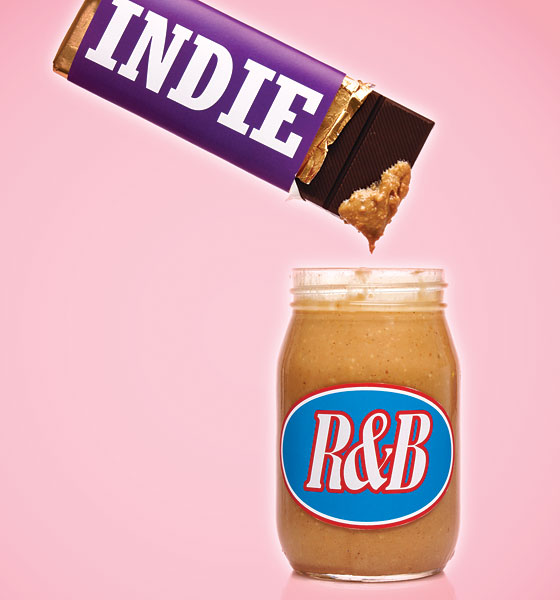
Most of the music Pat Grossi makes, under the name Active Child, has a familiar prettiness; he grew up singing in a boys’ choir, and his voice turned out to be a fine match for the dreamy synths he lays around it. The first single from his new album, however, goes someplace people don’t much associate with choir-voiced indie types. It’s steamy, deep, and full of clipped pleading. It sounds, or aspires to sound, roughly like the R&B slow jams on the radio.
In the summer of 2011, this is more typical than surprising. For years now, more and more indie musicians have been eager to engage with modern R&B, whether by sampling it, remixing it, singing it, or just claiming it as an influence. Funnily enough, plenty of R&B artists have been coming from the other direction, taking up the cultish style usually associated with indie artists. The acts in between aren’t exactly a genre; every last one of them seems to have a different agenda and a different frame of reference. But there are fans out there, surfing the crosscurrents and drawing lines between things—from bedroom experimentalists like How to Dress Well to quirky soul singers like Solange Knowles and Janelle Monáe.
Given the number of years we’ve already spent marveling at one another’s eclectic, iPods-on-shuffle taste in music, it’s not exactly surprising that these two worlds intersect. (Honestly, it’d be more shocking if they didn’t.) You’d never guess this, though, from the way the music is received: As it turns out, there’s something about this particular intersection that’s remarkably good at vexing listeners, sparking arguments, and pulling back the curtains on how people think about genre in the first place. In some places, this territory is lovingly mapped out by microblogs devoted to “indie R&B”; in others, the whole notion is sneered off as “hipster R&B.” (In March the joke term “PBR&B,” after Pabst Blue Ribbon beer, joined the list, mostly because it was too clever for anyone to resist using.) Online message boards struggle to pin down exactly what the stuff is; longtime R&B fans grumble about all the cool-hunting interlopers suddenly blundering into their territory; heated discussions ensue.
Many of the genre-benders refer back to the time, back at the turn of the millennium, when R&B on the radio was chock-full of the freethinking innovation indie geeks always liked to imagine was their thing. (Think: producers like Timbaland, singers like Aaliyah.) What’s so complicated about a little crossover, then? Well, race and class are involved. For decades, these two types of music have been seen as somehow opposites—if not always in sound, then at least in ethos. R&B often has a showbiz orientation: charismatic singers with skilled voices, flanked by professional musicians and songwriters, producing populist songs. Indie acts once prided themselves on being entirely different: anti-showbiz, more into arty niches than mass appeal, unimpressed by technical skill, and full of auteurs who write and record everything themselves. As far as press and critics go, R&B has often gotten the short end of that distinction, written off as empty pop product next to someone else’s middlebrow art.
That difference in ethos is part of why “indie R&B” can cause confusion and begs to be argued out: People rarely agree on what standards they’re meant to be applying anyway. Are the artists competing with the big voices and bigger personalities of R&B stars, or the sense of mood, style, and imagination indie fans tend to focus on? (Voices have been a funny sticking point: Few of the bedroom auteurs who want to make an imaginative hash of R&B sounds actually have the pipes to sing it convincingly.) The answer to that question varies wildly; it’s up to the listener to decide which artists to approach which way. Sometimes that leads to a strange rush to categorize what type of person the artist is—whether by the old crude racial divisions, or subtler cues about social class, or even by tracking which media outlets and fan groups seem receptive to them. (If it’s big on indie blogs or Tumblr, it must be for “hipsters”; if it’s big on Twitter or seems to have a diverse fan base, it must be “real.”)
But if you ask me, a lot of the appeal of this stuff is relaxing and figuring it out by ear—which means trusting the music itself. Most of these artists come from completely different worlds, but they tend to have one thing in common: Their music contains a patchwork of different standards, ideas, and ways of listening, some of which we’re not yet used to hearing combined in the same song. Some turn the passion of R&B into a disaffected, morning-after blur (like Frank Ocean and the Weeknd); others approach it with comic-book imagination, all bright colors and eccentric ideas (like J*Davey). Some treat soul singing as a distant, exotic land they can dream and reminisce about (like How to Dress Well); others as a familiar hometown that could use some weird new spots to hang out in (like Solange Knowles). Some resurrect familiar formats we haven’t heard in a while: Devonté Hynes, of Blood Orange, collaborates frequently with the rapper Theophilus London, and both have stylish new-wave aesthetics, redolent of the end of the eighties. (Besides, what were guys like Terence Trent D’Arby and Seal exploring back then, if not this patch of modernist pop?) And sometimes, with the best of these artists, it’s actually hard to tell precisely what they’re shooting for—which is the fun of it.
Listen to the Albums:
• Active Child, Curtis Lane
• How to Dress Well, Love Remains
• Solange Knowles, safe for the time being
• Janelle Monáe, The ArchAndroid (Suites II and III)
• Frank Ocean, Nostalgia, Ultra
• The Weeknd, House of Balloons
• J*Davey, “Mr. Mister”
• How to Dress Well, Love Remains
• Blood Orange, Terrible 7”
• Theophilus London, Timez Are Weird These Days